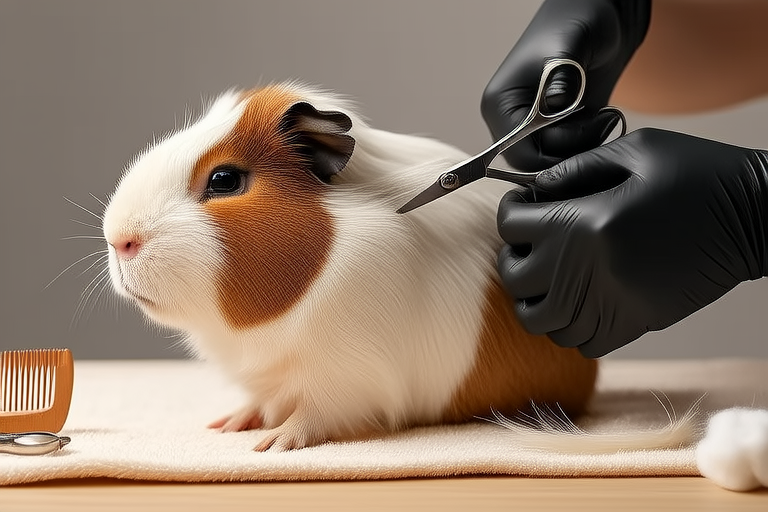Guinea Pig Grooming Basics: A Step-by-Short Guide for First-Time Owners
Welcome to the world of guinea pig ownership! Your new furry friend is sure to bring you joy and companionship. However, as with any pet, proper care and attention are crucial to their health and happiness. One of the most important aspects of guinea pig care is grooming. This guide will walk you through the basics of grooming your guinea pig, helping you understand why each step is necessary and how to make the process as stress-free as possible for both you and your pet.
Essential Grooming Tools
To ensure your guinea pig remains healthy and comfortable, it’s important to have the right tools on hand. Here’s a list of essentials:
- Soft-bristled brush: Helps remove loose hair and prevent mats.
- Nail clippers: Necessary for keeping nails trimmed to avoid overgrowth and discomfort.
- Tooth file or nail file: Used for smoothing sharp edges after clipping.
- Styptic powder: In case you accidentally cut too far and need to stop bleeding.
- Gentle shampoo: For occasional baths, if needed.
- Eye wipes: To gently clean around the eyes.
Having these items ready will make grooming easier and more effective. Always choose high-quality tools designed specifically for small animals to ensure safety and comfort.
Frequency of Grooming
The frequency of grooming depends on several factors including breed, coat type, and individual needs. Long-haired breeds like the Abyssinian or Peruvian require more frequent grooming compared to short-haired breeds like the American or Rex. As a general rule, aim to groom your guinea pig at least once a week. Regular grooming helps maintain their coat’s condition, prevents matting, and allows you to check for any potential health issues early.
Basic Grooming Techniques
Brushing
Brushing is one of the simplest yet most important grooming tasks. It helps keep your guinea pig’s coat smooth and free from tangles. Start by selecting a soft-bristled brush suitable for your guinea pig’s fur length. Begin brushing from the head towards the tail, ensuring that you cover all areas of the body.
Pay special attention to the underbelly and behind the ears where mats tend to form. If you encounter any knots, try to gently work them out with your fingers before continuing to brush. Remember, patience is key. Take breaks if your guinea pig becomes restless or uncomfortable.
Regular brushing also stimulates blood circulation and distributes natural oils throughout the coat, promoting overall skin health. Additionally, it provides an opportunity for bonding between you and your pet.
Nail Trimming
Nail trimming is another critical aspect of guinea pig care. Overgrown nails can cause discomfort and even interfere with walking properly. Use nail clippers designed for small animals and trim only the tip of each nail, avoiding the quick (the pink part containing blood vessels). The quick is usually visible in light-colored nails but may be harder to see in darker ones.
If you’re unsure about trimming nails yourself, consult a veterinarian who can show you the correct technique. After trimming, use a tooth file or nail file to smooth any rough edges. This prevents irritation when your guinea pig moves around its cage.
Trimming nails regularly not only ensures your guinea pig’s comfort but also reduces the risk of injury due to sharp claws. Moreover, it allows you to monitor the condition of their paws closely, detecting any signs of infection or injury early.
Teeth Checking
Guinea pigs have continuously growing teeth which need regular monitoring. Check your guinea pig’s teeth every few weeks by gently lifting their lips. Their incisors should meet evenly, forming a neat bite. Overgrown teeth can lead to difficulties eating and chewing, causing pain and malnutrition.
If you notice any misalignment or overgrowth, contact a veterinarian immediately. They may recommend filing down the teeth or providing specific dietary adjustments to help wear them naturally. Regular checks allow early intervention if there are any dental issues, ensuring your guinea pig maintains good oral hygiene.
Tips for Handling and Soothing Your Guinea Pig During Grooming Sessions
Handling your guinea pig correctly during grooming is essential for their comfort and your safety. Always support their body fully, especially their hindquarters, to prevent injury. Place one hand under their chest while supporting their rear end with the other hand.
To soothe your guinea pig, speak softly and offer treats as positive reinforcement. Some guinea pigs enjoy being petted or stroked gently along their back during grooming sessions. Others might prefer quietness and minimal interaction. Observe your pet’s reactions to find what makes them feel most relaxed.
Creating a calm environment for grooming is equally important. Choose a quiet space free from distractions and potential stressors. Using a towel or blanket as a grooming station can provide extra security for your guinea pig, making them feel more secure.
Conclusion
Grooming your guinea pig is not just about maintaining their appearance; it plays a vital role in their overall health and well-being. By following this step-by-step guide, you’ll be able to provide your pet with the care they need while building a strong bond. Remember, consistency is key – establish a routine and stick to it. With time, both you and your guinea pig will look forward to these moments together.
